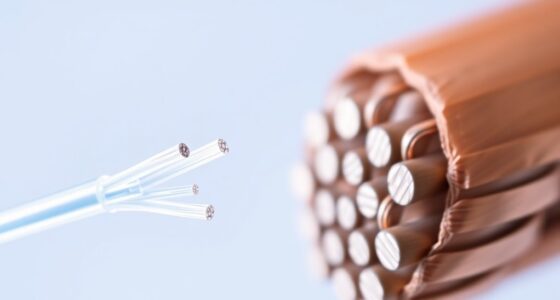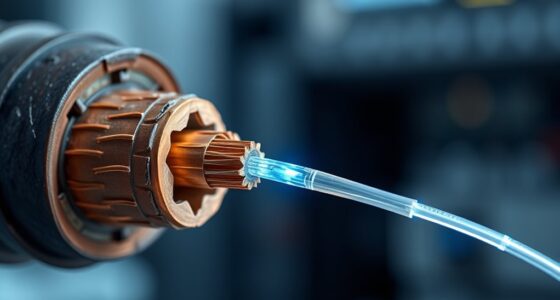When installing fiber optic cabling, careful planning is essential to ensure long-term performance and durability. You need to take into account proper protection strategies, such as conduit and strain relief, to prevent damage and environmental exposure. Attention to details like fiber cleaning and appropriate splicing methods can make a significant difference in connection quality. Understanding these key considerations helps you avoid common pitfalls and sets the foundation for a reliable network—something worth exploring further.
Key Takeaways
- Properly clean and prepare fiber ends to ensure minimal signal loss during splicing.
- Choose the appropriate splicing method (fusion or mechanical) based on application needs.
- Protect cables with suitable conduit, enclosures, and strain relief to withstand environmental and mechanical stress.
- Avoid sharp bends and excessive pulling during installation to prevent fiber damage.
- Plan cable routes to ensure easy access, minimal interference, and long-term maintenance.

Installing fiber optic cabling is a essential step in building a high-speed, reliable network. When you set out to lay down this infrastructure, you need to pay close attention to fiber splicing and cable protection. These elements are indispensable to guarantee your fiber network performs at its best and lasts over time.
Fiber splicing is the process of joining two fiber optic cables together, and it’s critical for maintaining signal integrity. You’ll want to make sure that your splicing is done precisely and professionally. Poor splicing can lead to signal loss or degradation, which defeats the purpose of installing high-quality fiber. There are two main types of splicing: fusion splicing and mechanical splicing. Fusion splicing involves melting the fiber ends together with an electric arc, creating a seamless connection with minimal loss. Mechanical splicing, on the other hand, aligns the fibers using a connector and an index-matching gel. While mechanical splicing is easier and quicker, fusion splicing offers the lowest loss and is preferred for long-term or important connections. Whichever method you choose, clean and prepare the fiber carefully before splicing to prevent dirt or debris from causing connection issues. Proper fiber cleaning is essential to ensure optimal splice quality and minimize signal loss.
Cable protection is equally essential in fiber optic installation. Fiber cables are delicate and can be easily damaged during installation or through environmental factors. You should use proper conduit, jacketed cables, and protective enclosures to shield the fibers from mechanical stress, moisture, and temperature fluctuations. When running cables underground or through harsh environments, make sure they are housed in robust conduit systems designed specifically for fiber optics. During installation, avoid bending the cables sharply or pulling them with excessive force, as this can cause microbends or breaks that impair signal quality. It’s also wise to install strain relief devices at connection points to prevent stress from pulling on the splices or connectors. Proper cable protection not only prolongs the lifespan of your network but also reduces the risk of costly repairs or replacements down the line.
Frequently Asked Questions
What Is the Average Lifespan of Fiber Optic Cables?
Fiber optic cables typically last between 25 to 50 years, depending on fiber durability and installation conditions. You can expect good cable longevity if you protect the cables from physical damage, moisture, and extreme temperatures. Proper handling and regular maintenance help extend the lifespan, ensuring reliable performance over decades. Keep in mind that advancements in technology may influence overall fiber durability, potentially increasing the longevity of future fiber optic systems.
How Do I Troubleshoot Common Fiber Optic Connection Issues?
Think of your fiber optic connection as a delicate dance. To troubleshoot, first check the fiber optic connectors for dirt or damage—these are the dancers’ shoes. Next, test for signal attenuation; if signals weaken, it’s like the music fading. Clean connectors with isopropyl alcohol, guarantee proper fusion splicing, and replace damaged cables. Regular maintenance keeps your connection smooth, preventing issues before they disrupt your flow.
Are There Specific Safety Precautions During Installation?
During installation, you should wear appropriate safety gear like gloves and eye protection to prevent injuries. Handle hazards such as sharp fibers carefully to avoid cuts or eye damage. Always follow safety protocols, guarantee proper grounding, and avoid bending fibers sharply to prevent breakage. Keep your workspace clean and organized, and be aware of electrical hazards nearby. These precautions help ensure a safe and successful fiber optic installation.
Can Existing Cabling Infrastructure Support Fiber Optic Upgrades?
Did you know that over 60% of existing cabling infrastructure can often support fiber optic upgrades? You should conduct a thorough infrastructure assessment to determine cabling compatibility before upgrading. This step helps identify whether your current setup can handle fiber optic cables or if you need to replace or augment existing cables. Proper assessment saves time and money, ensuring a smooth shift to faster, more reliable fiber optic connectivity.
What Are the Cost Differences Between Single-Mode and Multi-Mode Cables?
You’ll find that single-mode cables generally cost more upfront due to their advanced manufacturing and longer-distance capabilities, leading to higher installation expenses. Multi-mode cables are cheaper initially and easier to install, making them suitable for shorter distances. The cost comparison depends on your network needs; if you require long-distance transmission, investing in single-mode might save money long-term, despite higher initial costs.
Conclusion
So, next time you’re installing fiber, remember: treat those tiny cables like fragile butterflies, not rebellious snakes. Protect them with conduit, avoid bending them like a pretzel, and keep them squeaky clean—because a tangled mess or a dusty splice won’t just ruin your day, it’ll haunt your network’s dreams forever. Follow these tips, and your fiber will stay happy, healthy, and ready to deliver lightning-fast data—no drama required.









